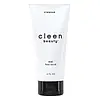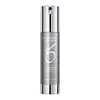What's inside
What's inside
 Key Ingredients
Key Ingredients

 Benefits
Benefits

 Concerns
Concerns

 Ingredients Side-by-side
Ingredients Side-by-side

Water
Skin ConditioningGlycerin
HumectantCaprylic/Capric Triglyceride
MaskingPhytelephas Aequatorialis Seed Powder
Cetearyl Alcohol
EmollientCocamidopropyl Betaine
CleansingStearic Acid
CleansingCetyl Alcohol
EmollientCarthamus Tinctorius Seed Oil
MaskingEuterpe Oleracea Pulp Powder
AbrasiveEuterpe Oleracea Fruit Oil
Skin ConditioningPersea Gratissima Oil
Skin ConditioningBertholletia Excelsa Seed Oil
EmollientTocopheryl Acetate
AntioxidantJojoba Esters
EmollientTocopherol
AntioxidantAcrylates/C10-30 Alkyl Acrylate Crosspolymer
Emulsion StabilisingEthylhexylglycerin
Skin ConditioningXanthan Gum
EmulsifyingPhenoxyethanol
PreservativeSodium Hydroxide
BufferingCI 77491
Cosmetic ColorantWater, Glycerin, Caprylic/Capric Triglyceride, Phytelephas Aequatorialis Seed Powder, Cetearyl Alcohol, Cocamidopropyl Betaine, Stearic Acid, Cetyl Alcohol, Carthamus Tinctorius Seed Oil, Euterpe Oleracea Pulp Powder, Euterpe Oleracea Fruit Oil, Persea Gratissima Oil, Bertholletia Excelsa Seed Oil, Tocopheryl Acetate, Jojoba Esters, Tocopherol, Acrylates/C10-30 Alkyl Acrylate Crosspolymer, Ethylhexylglycerin, Xanthan Gum, Phenoxyethanol, Sodium Hydroxide, CI 77491
Water
Skin ConditioningGlycolic Acid
BufferingCaprylic/Capric Triglyceride
MaskingLactic Acid
BufferingGlycerin
HumectantPropylene Glycol
HumectantSodium Hydroxide
BufferingPEG-100 Stearate
Squalane
EmollientGlyceryl Stearate
EmollientSteapyrium Chloride
AntimicrobialCarthamus Tinctorius Seed Oil
MaskingChamomilla Recutita Flower Extract
MaskingCamellia Sinensis Leaf Extract
AntimicrobialAloe Barbadensis Leaf Juice
Skin ConditioningTocopheryl Acetate
AntioxidantRetinyl Palmitate
Skin ConditioningCetyl Alcohol
EmollientMyristyl Alcohol
EmollientStearyl Alcohol
EmollientDimethicone
EmollientAllantoin
Skin ConditioningDisodium EDTA
Sodium Benzoate
MaskingCitric Acid
BufferingPhenoxyethanol
PreservativeEthylhexylglycerin
Skin ConditioningPotassium Sorbate
PreservativeWater, Glycolic Acid, Caprylic/Capric Triglyceride, Lactic Acid, Glycerin, Propylene Glycol, Sodium Hydroxide, PEG-100 Stearate, Squalane, Glyceryl Stearate, Steapyrium Chloride, Carthamus Tinctorius Seed Oil, Chamomilla Recutita Flower Extract, Camellia Sinensis Leaf Extract, Aloe Barbadensis Leaf Juice, Tocopheryl Acetate, Retinyl Palmitate, Cetyl Alcohol, Myristyl Alcohol, Stearyl Alcohol, Dimethicone, Allantoin, Disodium EDTA, Sodium Benzoate, Citric Acid, Phenoxyethanol, Ethylhexylglycerin, Potassium Sorbate
Ingredients Explained
These ingredients are found in both products.
Ingredients higher up in an ingredient list are typically present in a larger amount.
This ingredient is an emollient, solvent, and texture enhancer. It is considered a skin-softener by helping the skin prevent moisture loss.
It helps thicken a product's formula and makes it easier to spread by dissolving clumping compounds.
Caprylic Triglyceride is made by combining glycerin with coconut oil, forming a clear liquid.
While there is an assumption Caprylic Triglyceride can clog pores due to it being derived from coconut oil, there is no research supporting this.
Learn more about Caprylic/Capric TriglycerideCarthamus tinctorius seed oil comes from safflower, one of humanity's oldest crops.
Safflower seed oil contains a high percentage of linoleic acid and oleic acid. It also contains Vitamin E. These three components are effective moisturizers.
Vitamin E helps nourish your skin's lipid barrier. It is also a potent antioxidant. Antioxidants help fight free-radical molecules, or unstable molecules that may damage your skin cells.
Due to its high fatty acid content, this ingredient may not be malassezia folliculitis safe.
Thoughout history, safflower has been used for dying fabrics and in food as a saffron substitute.
Learn more about Carthamus Tinctorius Seed OilCetyl Alcohol is a fatty alcohol. Fatty Alcohols are most often used as an emollient or to thicken a product.
Its main roles are:
Though it has "alcohol" in the name, it is not related to denatured alcohol or ethyl alcohol.
The FDA allows products labeled "alcohol-free" to have fatty alcohols.
Learn more about Cetyl AlcoholEthylhexylglycerin (we can't pronounce this either) is commonly used as a preservative and skin softener. It is derived from glyceryl.
You might see Ethylhexylglycerin often paired with other preservatives such as phenoxyethanol. Ethylhexylglycerin has been found to increase the effectiveness of these other preservatives.
Glycerin is already naturally found in your skin. It helps moisturize and protect your skin.
A study from 2016 found glycerin to be more effective as a humectant than AHAs and hyaluronic acid.
As a humectant, it helps the skin stay hydrated by pulling moisture to your skin. The low molecular weight of glycerin allows it to pull moisture into the deeper layers of your skin.
Hydrated skin improves your skin barrier; Your skin barrier helps protect against irritants and bacteria.
Glycerin has also been found to have antimicrobial and antiviral properties. Due to these properties, glycerin is often used in wound and burn treatments.
In cosmetics, glycerin is usually derived from plants such as soybean or palm. However, it can also be sourced from animals, such as tallow or animal fat.
This ingredient is organic, colorless, odorless, and non-toxic.
Glycerin is the name for this ingredient in American English. British English uses Glycerol/Glycerine.
Learn more about GlycerinPhenoxyethanol is a preservative that has germicide, antimicrobial, and aromatic properties. Studies show that phenoxyethanol can prevent microbial growth. By itself, it has a scent that is similar to that of a rose.
It's often used in formulations along with Caprylyl Glycol to preserve the shelf life of products.
Sodium Hydroxide is also known as lye or caustic soda. It is used to adjust the pH of products; many ingredients require a specific pH to be effective.
In small amounts, sodium hydroxide is considered safe to use. However, large amounts may cause chemical burns due to its high alkaline.
Your skin has a natural pH and acid mantle. This acid mantle helps prevent harmful bacteria from breaking through. The acid mantle also helps keep your skin hydrated.
"Alkaline" refers to a high pH level. A low pH level would be considered acidic.
Learn more about Sodium HydroxideTocopheryl Acetate is AKA Vitamin E. It is an antioxidant and protects your skin from free radicals. Free radicals damage the skin by breaking down collagen.
One study found using Tocopheryl Acetate with Vitamin C decreased the number of sunburned cells.
Tocopheryl Acetate is commonly found in both skincare and dietary supplements.
Learn more about Tocopheryl AcetateWater. It's the most common cosmetic ingredient of all. You'll usually see it at the top of ingredient lists, meaning that it makes up the largest part of the product.
So why is it so popular? Water most often acts as a solvent - this means that it helps dissolve other ingredients into the formulation.
You'll also recognize water as that liquid we all need to stay alive. If you see this, drink a glass of water. Stay hydrated!
Learn more about Water